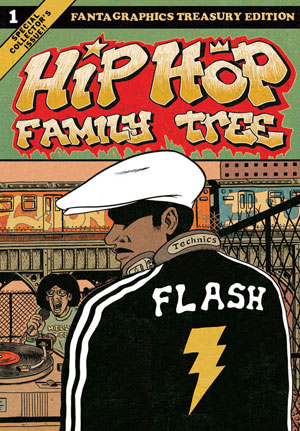Holiday Gift Bag: Hip Hop Family Tree
It’s December, and that means everyone’s looking for more ideas for presents for family and friends, so let’s take another look into our Holiday Gift Bag for some more great stuff we can give. Today, we’re gonna check out Hip Hop Family Tree by Ed Piskor.
Piskor is a cartoonist best known for his Wizzywig graphic novel, and he’s been running this new series as a webcomic on the Boing Boing website. It’s basically a crash course on the history, culture, and personalities of hip hop, starting in the mid-1970s, when most of the elements of what we now call hip hop came together.
I’ll say, first, that I simultaneously want to call this a very brief history and a very in-depth history. It rockets through a dizzying number of musicians, both obscure and famous, more and more of them on almost every page, so it feels like we’re just hitting the high points — but on the other hand, the entire book covers a fairly short span of years. All those names were people who were pretty influential in the early days of hip hop, so while the book moves fast, it’s also covering almost every person who’d need to be covered.
And I’ll also say, as a white boy who grew up in rural New Mexico, that a lot of the stuff I read here was completely new to me — and completely amazing. The guy who invented record scratching did it completely by accident? Afrika Bambaataa was a gang leader who got into the music scene to steer his followers in more nonviolent directions? Fab Five Freddy and Chuck D both got into hip hop through art? Blondie helped push rap into the mainstream? They didn’t teach this stuff in school, and I kinda wish they did.
And it’s not just musicians we get to meet. We get introduced to a lot of producers and moguls — Russell Simmons, Sylvia Robinson, Rick Rubin, and tons of others, both small- and big-time. And a lot of the time, they come off a lot worse than any of the performers — they often seem greedier, more conniving, and sometimes less forward-thinking than the musicians. But they’re still super-important, because they were the ones putting rappers and DJs on records when no one else thought there was any point.
And we get a few micro-moments here and there — a few single nights or single encounters that get multiple pages devoted to them. Maybe the best of the bunch is the epic battle rap between Busy Bee Starski and Kool Moe Dee.
Verdict: Thumbs up. I seriously love this book so much. My musical education was stunted for years, thanks in part to access to little beyond Top 40 and AOR radio in my wayward youth, and this book introduced me to a lot of old-school performers I’d never heard much of. So it was really useful for helping me learn that I had so much I needed to learn.
Piskor’s art style is beautifully stylized here. His caricatures are often hilarious all on their own — Russell Simmons nearly never comes off well, Sylvia Robinson always wears the same outfit, Melle Mel always looks musclebound and furious, Grandmaster Flash always looks stylish, Afrika Bambaataa always looks gigantic and terrifying. Of course, they don’t look a lot like that in real life, but it’s a great way to characterize the major players quickly. The artwork is funny and expressive and just fun to look at.
And the book itself looks amazing. It’s an oversized comic — 9×13 inches, so you’ll have to store this one in the big bookcase. The pages are yellowed, like an old ’70s comic, and it’s even colored in old-school four-color style, so it almost feels like you’re reading a hip hop comic that was actually made in the ’70s.
It’s gonna be a perfect gift for the hip hop fan in your life — or for someone who you need to turn into a hip hop fan. Go pick it up.
Comments off

